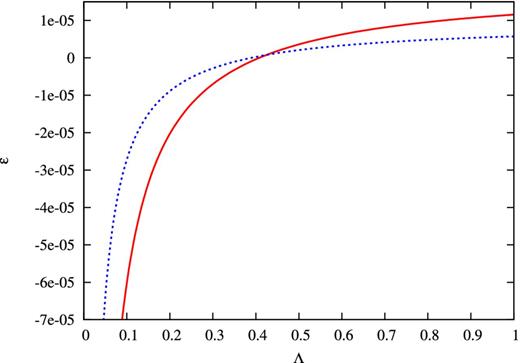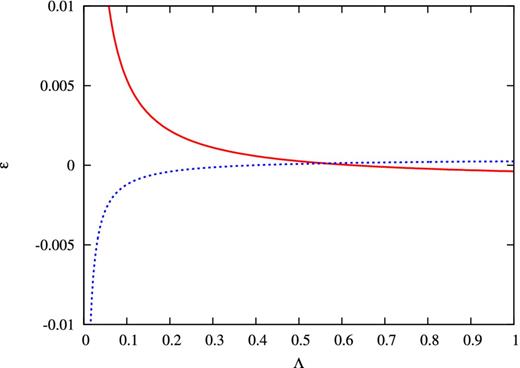-
PDF
- Split View
-
Views
-
Cite
Cite
Shin’ichirou Yoshida, Assessment of Cowling approximation in computing ellipticity of a magnetized non-barotropic star, Monthly Notices of the Royal Astronomical Society, Volume 435, Issue 1, 11 October 2013, Pages 893–896, https://doi.org/10.1093/mnras/stt1362
Close - Share Icon Share
Abstract
A deformation of a neutron star due to its own magnetic field is an important issue in gravitational wave astronomy, since a misaligned rotator with small ellipticity may emit continuous gravitational wave that may be observed by ground-based detectors. Recently, Mastrano et al. evaluated deformations induced by both poloidal and toroidal magnetic field in non-barotropic model stars by neglecting the gravitational field perturbation (Cowling approximation). Following their treatment in non-barotropic fluid and magnetic configurations, we here assess the effect of gravitational perturbation that they neglected. We show that the ellipticity computed with gravitational perturbation is roughly twice as large as that obtained by Cowling approximation. We should allow this amount of error in using the neat analytic treatment proposed by them.
1 INTRODUCTION
A rotating neutron star with a non-axisymmetric deformation with respect to the rotational axis emits gravitational wave because of its time-dependent mass quadrupole. The quadrupole scales as the ellipticity ϵ of the deformed star (see equation 11). Therefore, there is a strong astrophysical motivation to compute how much ellipticity we may expect in neutron stars. One of the possibilities that have been proposed to allow misaligned deformation of rotating neutron stars is the magnetic deformation of the stars. Radio pulsars are regarded as misaligned rotators with strong magnetic field [with typical surface fields B ∼ 108 T (1012 Gauss)]. We now have another class of neutron stars with superstrong field (B ≥ 109 T), i.e. ‘magnetars’. Although the magnetic fields outside the stars are usually assumed to be dipolar, the configuration of magnetic field inside the stars is unknown. Chung & Melatos (2011) give observational evidences of the dipolar field in some of the millisecond pulsars, while there are indications that some of the neutron stars may have multipole magnetic field (see Mastrano, Lasky & Melatos 2013).
The deformation of a neutron star due to magnetic field strongly depends on its internal field configuration and we may have a clue to the internal magnetic configuration when the gravitational waves from misaligned rotators are observed.
The studies on the issue of magnetic deformation of neutron stars have been mainly done under the assumptions of barotropic stars (general relativistic studies are found for instance in Bonazzola & Gourgoulhon 1996; Colaiuda et al. 2008; Ciolfi, Ferrari & Gualtieri 2010; Newtonian counterparts are found in Tomimura & Eriguchi 2005; Yoshida, Yoshida & Eriguchi 2006; Haskell et al. 2008; Lander & Jones 2009; Fujisawa, Yoshida & Eriguchi 2012).
Strictly speaking a neutron star is, however, a non-barotropic star which has a density stratification due to a gradient of chemical composition (Reisenegger & Goldreich 1992; Reisenegger 2009). In this case, the restrictions on a possible magnetic field structure inside may be rather relaxed compared to the barotropic stars. This is because the gas pressure p is not restricted by a one-parameter equation of state of density ρ such as p = p(ρ).
Under this physical picture, Mastrano et al. (2011, 2013) evaluated deformations induced by both poloidal and toroidal magnetic field in non-barotropic model stars. They first prescribe the functional form of magnetic field and compute the density perturbation induced by the Maxwell stress. In these studies, the perturbation of gravitational potential is neglected (Cowling approximation). The former studies of deformations of neutron stars with crust suggest that Cowling approximation is ‘according to the stellar perturbation theory (Unno et al. 1989), the perturbed gravitational potential for non-axisymmetric perturbations becomes asymptotically zero with increasing number of azimuthal nodes’. For axisymmetric perturbation of a lower order this is not the case, and we may expect a large number of errors in neglecting gravitational perturbation. It is therefore important to know how large errors we may have in adopting Cowling approximation to compute a small deformation of a star by magnetic stress.
In this paper, we compare the ellipticity of magnetized non-barotropic star with and without gravitational perturbation, by following the formulation in Mastrano et al. (2011, 2013).
2 FORMULATION
3 RESULTS

Ellipticity of a stellar model induced by magnetic field (equation 4) is plotted as a function of Λ which measures the relative strength of poloidal magnetic field to the total field. The solid line takes into account gravitational perturbation, while the dotted line is for Cowling approximation. The non-magnetic stellar model has a parabolic density profile as equation (1). We fix |$B_0^2/(\mu _0 p_c)$| to be 10−7 and ηP to be unity.

The same as Fig. 1 except that the non-magnetic stellar model has a density profile of N = 1 polytrope.

The same as Fig. 1 except that the non-magnetic stellar model has an off-centred density maximum.
4 SUMMARY AND COMMENTS
Mastrano et al. (2011, 2013) computed the ellipticity induced by the Maxwell stress of density-stratified stars with magnetic field. It is assumed that the deformation is so small that it is treated as a linear perturbation to the non-bartotropic spherical equilibrium. With Cowling approximation in which the Eulerian perturbation of gravitational potential is neglected, they obtain a neat analytic formula for the ellipticity assuming magnetic field to have a prescribed analytic distribution. We assessed the reliability of Cowling approximation in their model by taking the perturbed gravitational potential into account. As is expected from the stellar perturbation theory, Cowling approximation gives rise to a large error in density distribution and the ellipticity depending on the spherical background star as well as on the magnetic distribution. For a comparatively realistic case, however, the deviation of the ellipticity due to Cowling approximation from the actual value may be smaller than an order of magnitude. The result is consistent with the former studies (Ushomirsky, Cutler & Bildsten 2000; Cutler, Ushomirsky & Link 2003; Haskell, Jones & Andersson 2006) in which the effects of Cowling approximation on the ellipticity due to crust mountains of neutron stars are estimated. Although the magnetic field instead of the crust shear modulus deforms the stars here, the results obtained are consistent with those in the former studies, i.e. neglecting the gravitational perturbation may suffer a few hundred per cent of errors in the ellipticity for astrophysically relevant models.
On the other hand, by comparing the full and the Cowling treatment for non-trivial density distribution we see that neglecting gravitational potential may lead to a rather erroneous result. It may be safe to take into account the gravitational perturbation in computing magnetic deformation of a star.
Finally, an extension of the formulations by Tokyo group (Tomimura & Eriguchi 2005; Yoshida et al. 2006; Fujisawa et al. 2012) to include non-barotropic effect may be useful to compute consistently the effect of magnetic field and gravity on the ellipticity of magnetized stars.
The author thanks the anonymous reviewer for useful comments.



